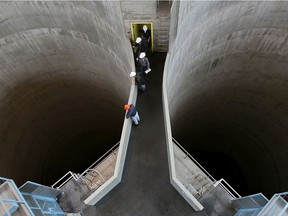City will dump wastewater during construction of ozonation plant

Article content
Montreal’s long-awaited ozonation wastewater treatment plant will finally open in December 2024 — six years later than originally scheduled and at triple the price, the city announced Wednesday.
Advertisement 2
Article content
Quebec’s biggest environmental project in decades, the $696.2-million facility will be a world leader in removing emerging contaminants, said Maja Vodanovic, the mayor of Lachine and executive committee member responsible for water.
Emerging contaminants are potentially harmful chemicals like pharmaceuticals, pesticides, industrial chemicals and personal care products that are not commonly monitored in or regulated in waterways.
“We’re going to remove almost 100 per cent of viruses and up to 85 per cent of all toxic substances except heavy metals,” she said.
“Antidepressants and other types of medication will be destroyed and we know that it affects the water,” Vodanovic added.
On Wednesday, the city’s executive committee approved a $93.2-million contract to build giant Pomerleau for work on the ozonation facility at the J.-R.-Marcotte wastewater treatment plant in Rivière-des-Prairies.
advertisement 3
Article content
The work — including construction of a temporary canal to allow the treatment plant to continue operating during construction — will be carried out from Nov. 1, 2022 to April 30, 2023 and from Nov. 1, 2023 to April 30, 2024.
During that time, the treatment plant’s capacity will be reduced, so major rainfalls or snowmelt events are expected to cause overflows of wastewater into the St. Lawrence River, Montreal Water Director Chantal Morissette said.
But they will not be on the scale of the so-called “Flushgate” episode in November 2015, when the city dumped eight billion liters of untreated sewage into the river during repairs to a main sewer collector, she added.
“It’s not at all comparable,” Morissette said, noting that the 2015 incident lasted four days and spewed untreated waste from a sewer collector the size of a métro tunnel.
advertisement 4
Article content
The dates for the construction project were chosen to have the least impact on recreational activities on the St. Lawrence or Prairies rivers, she said.
The ozonation plant will be by far the world’s largest when it opens, treating 45 per cent of Quebec’s wastewater.
“It could be a forerunner,” Vodanovic said.
“Other cities are watching us, asking ‘Is this going to work?’” she added.
Former mayor Gérald Tremblay first announced the ozonation plant in 2008, promising it would “make Montreal a leader in wastewater disinfection.” The cost was initially pegged at $200 million.
At the time, some critics said the technology was too expensive, urging the city to opt instead for UV treatment, which is more common.
Ozonation injects ozone gas into wastewater to disinfect it.
advertisement 5
Article content
But UV treatment is not effective against emerging contaminants, said Benoit Barbeau, a professor of engineering at Polytechnique Montréal.
In opting for ozonation, Montreal “made a decision that went beyond regulatory obligations,” he said.
While most governments do not yet regulate the presence of emerging contaminants in the natural environment, that day is coming, with new federal norms coming into force in 2030, he said.
In the past, cities treated wastewater with chlorine, a practice now banned in Quebec.
Barbeau acknowledged the ozonation plant is immensely expensive. “It is a very big project,” he said.
However, biological treatments for wastewater, which use bacteria or other small organisms to remove contaminants, are even more expensive, he said.
advertisement 6
Article content
Emerging contaminants pose a threat to the biodiversity of the St. Lawrence River, Morissette said.
“It’s been shown that Montreal’s wastewater contains a large quantity of these products. So we are happy to have chosen this technology because it covers a broader spectrum,” she said.
Morissette said the city has already spent $140 million of the $696.2-million budget on preparatory work, including construction of an electric substation to supply power.
Most of that work, including structures for cooling, ozone destruction and pumping, had not been included in the original estimates, which has contributed to the ballooning cost of the project, she said.
-
Montreal’s ozonation plant facing delays — and questions
-
Montreal’s eco-credibility swirled down the toilet with Flushgate

